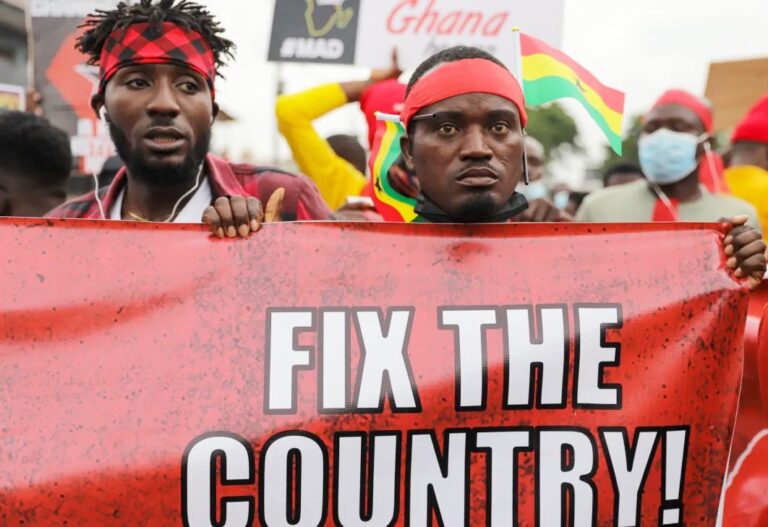By Alex Ababio
ACCRA, Ghana — These days, Emmanuel Elikem jumps at the sound of his phone vibrating. On August 4 , 2021, the 24-year-old mechanic joined thousands of citizens rallying at Accra’s Independence Square to protest Ghana’s worsening economic situation. By the end of the day, police had stormed his Kokomlemle home and hauled him away. His “offense”? His mobile phone’s GPS placed him at the demonstration.
“They pulled out a tablet and showed me a map,” Emmanuel recalls in a near whisper, gripping his teacup tightly. “I saw my blue dot travel from the protest straight to my home. The officer told me, ‘You think your phone is your friend? We see everything.’”
He spent three nights in custody, beaten for allegedly “disturbing the peace.” When his Samsung was returned, it had been completely wiped.
The Digital Dragnet
Emmanuel’s case was not isolated. A joint investigation by Citizen Lab and AfriTECH found that during the 2021 #FixTheCountry protests, Ghana Police illegally tracked 127 demonstrators using GPS. The method relied on Stingray surveillance devices—military-grade equipment that imitates cell towers to pinpoint a phone’s location—sidestepping Ghana’s Data Protection Act (2012).
Dr. Tricia Akumfi, a digital forensics specialist with Citizen Lab, explained:
“We examined network logs from the protest dates. Police had at least 12 Stingray units deployed around demonstration areas. These devices hijack phone connections, harvesting GPS pings, IMSI numbers, and call logs—without warrants. It’s like a digital form of kidnapping.”
The technology was traced to Gamma Group, an Egyptian contractor hired under the police’s 2020 “Project Shield” counterterrorism plan. Internal records reveal $3.2 million was paid for “mobile tracking solutions.”
“They Knew Every Move”
Kwame Asare (name changed for safety), a nurse who treated injured protesters, recalled an incident at Korle Bu Hospital:
“I was wrapping a boy’s head when two officers tapped my shoulder. They knew I had been at Circle earlier because my phone ‘pinged near a vandalized bus.’ I pleaded with them—my patient was bleeding. They replied, ‘Your phone is your witness.’”
His real “crime” was sharing emergency medical requests via Signal. Police seized his devices, and his medical license was suspended for “unlawful assembly.”
The Technology of Tyranny
Roughly the size of a small suitcase, Stingrays—also known as IMSI catchers—can be installed in vehicles to intercept every phone signal within a 500-meter range. During the #FixTheCountry protests, data from Citizen Lab showed:
4,812 phones were forced to connect to police-controlled networks near Black Star Square.
93% had their GPS coordinates recorded and mapped.
0 court warrants were issued for this surveillance.
Kofi Abotsi, a technology lawyer at Africa Digital Rights Hub, noted:
“This clearly breaches Article 18(2) of the Constitution, which prohibits interception without judicial approval. Police leaned on the vague ‘national security’ provisions in the Cybersecurity Act to justify mass spying.”
The Human Toll
The list of victims spans different walks of life:
Ama Serwah (23), a student, was traced to her hostel after live-streaming a protest. She was charged with “cyber incitement.”
Razak Kojo (31), a trader, was arrested because his GPS data placed him near a burned kiosk—despite bank records showing he was elsewhere.
Nana Esi (45), a teacher, lost her job after police told her school she attended “an illegal gathering.” She had actually been buying asthma medicine at a pharmacy.
The Cover-Up
In 2021, Police Commissioner John Kudalor dismissed the allegations outright: “We respect citizens’ privacy. GPS tracking claims are fake news.”
However, leaked documents from the Police Intelligence Directorate (PID) tell a different story. One file reads:
“Subject 88761 (Elikem, E.) moved from protest zone to residence… Apprehend for interrogation.” (Case File #PID/2021/88761)
Why GPS Became the Weapon of Choice
Traditional surveillance was ineffective—activists relied on burner phones and encrypted platforms. GPS data allowed police to:
1. Track movements in real time during protests.
2. Punish participants retroactively by arresting them days later.
3. Instill fear by proving phones could betray their owners.
Dr. Nana Ama Adomah, a psychologist, warned: “Many now suffer from what I call ‘digital paranoia.’ They see their phones as informants. Emmanuel can’t even hold a smartphone without sweating.”
The Legal Void
The Data Protection Commission received 42 complaints from citizens alleging GPS-based targeting during the protests. Not a single prosecution resulted.
Mary Addo, then DPC Director, admitted: “We lack the capacity to investigate state surveillance.”
Efforts by Parliament’s Constitutional Committee to tighten surveillance oversight stalled after police argued GPS tracking was “essential for public order.”
Built to Crush Dissent
According to one anonymous PID officer, the program had a name: “Operation Blue Dot.”
“We were told protesters were terrorists. Orders came from the top. Stingrays were rolled out at hotspots, GPS fed into our ‘GeoTrax’ system, and arrest teams followed up at homes and workplaces.”
“We Carry Ghana on Our Heads”
Back in his cramped one-room home, Emmanuel now uses a basic Nokia 3310 without GPS.
“I miss taking pictures of my baby,” he says quietly. “But if they track me again, they’ll see I’m just a man trying to live. Is that a crime in Ghana now?”
Outside, a street hawker calls out the old protest slogan: “We carry Ghana on our heads!” The words ring in the air, but the silence after them speaks volumes—this is a country where the weight of surveillance sits in every citizen’s pocket.

